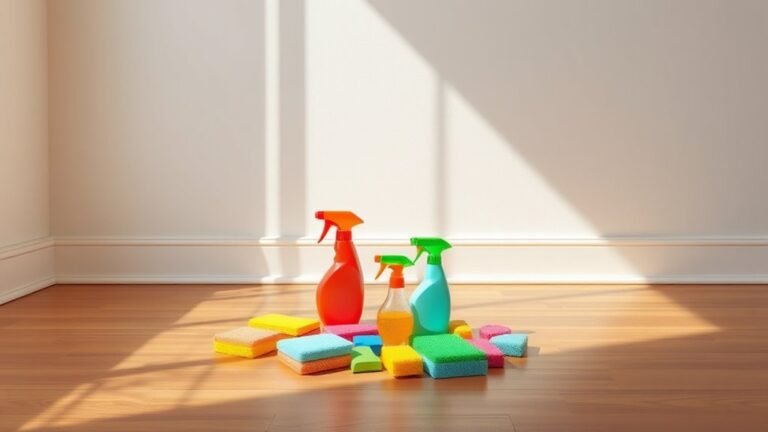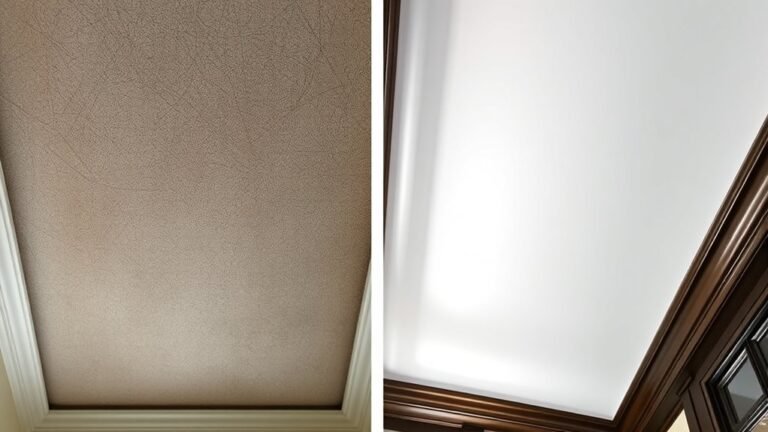Deep Cleaning Checklist for Grease
To deep clean grease effectively, start by identifying high-grease areas like stovetops, exhaust hoods, and cabinets near cooking zones. Gather essential supplies such as gloves, eco-friendly degreasers, microfiber cloths, and scrub brushes. Prepare surfaces by removing loose debris, then apply degreasers and scrub gently. Don’t forget to clean sinks, drains, and floors thoroughly to prevent buildup. With the right approach and tools, you’ll restore a fresh kitchen quickly—and there’s more to learn about maintaining this clean environment efficiently.
Identify High-Grease Areas

Before diving into deep cleaning, you’ll want to pinpoint the areas where grease tends to build up the most. Identifying grease hotspots helps you focus your efforts and reclaim your kitchen’s freedom from stubborn grime. Pay close attention to kitchen zones like stovetops, range hoods, and backsplashes—these spots catch the most airborne grease. Don’t forget cabinet doors near cooking areas and the inside edges of microwave doors. Even light switches or handles close to cooking stations can harbor greasy residue. By knowing exactly where grease collects, you avoid wasting time and energy on less dirty areas. This targeted approach gives you control and efficiency, so your deep cleaning feels less like a chore and more like freeing up your space for what truly matters.
Gather Necessary Cleaning Supplies
You’ll need a handful of essential cleaning supplies to tackle deep cleaning effectively. Start by gathering your essential tools: sturdy scrub brushes, microfiber cloths, and a reliable spray bottle. Don’t forget gloves to protect your skin while working through tough grease. For those who value freedom and sustainability, choosing eco friendly options like plant-based degreasers and biodegradable sponges is a smart move. These products clean powerfully without harsh chemicals, letting you maintain a fresh space and peace of mind. Having everything ready before you start means you won’t be interrupted, helping you move freely through your cleaning process. With the right supplies in hand, you’re set to conquer grease build-up efficiently and responsibly.
Prepare Surfaces for Cleaning

Three simple steps can make preparing your surfaces for cleaning much easier. First, clear the area by removing any loose items or debris, giving you full access. Next, choose the right cleaning techniques based on the surface material—whether it’s stainless steel, tile, or wood—to avoid damage. Finally, protect nearby areas with cloths or tape to keep your work contained.
Surface preparation is key to effective grease removal. By properly setting the stage, you’ll make the actual cleaning faster and more thorough. You’re not just scrubbing; you’re creating freedom from grime in a way that respects your space. Remember, good surface preparation means less effort later and better results. It’s the foundation for a truly deep clean.
Degrease Kitchen Appliances
When it comes to degreasing your kitchen appliances, using the right techniques can make all the difference. You’ll want to choose safe cleaning products that effectively break down grease without damaging surfaces. Let’s explore the best methods to get your appliances sparkling clean.
Effective Degreasing Techniques
Cleaning kitchen appliances effectively requires the right degreasing techniques to tackle stubborn buildup. Start by choosing powerful yet safe products—biodegradable cleaners let you break free from harsh chemicals while still cutting through grease. For tougher grime, industrial degreasers offer heavy-duty strength but use them sparingly to maintain control over your cleaning environment. Apply degreasers directly on greasy surfaces, letting them sit briefly to loosen buildup. Then, scrub with a non-abrasive brush or cloth to avoid damaging your appliances. Rinse thoroughly afterward to remove residue and prevent streaks. Regularly repeating this process keeps grease from hardening and saves you time later. By mastering these techniques, you gain freedom from stubborn dirt and maintain your kitchen appliances’ efficiency and appearance with confidence.
Safe Cleaning Products
Although powerful degreasers can tackle tough buildup, choosing safe cleaning products is crucial to protect your appliances and health. You don’t have to rely on harsh chemicals that can damage surfaces or cause irritation. Instead, explore eco friendly options that are both effective and gentle. Homemade cleaners using simple ingredients like vinegar, baking soda, and lemon juice offer a natural way to break down grease without harmful fumes. These solutions give you the freedom to clean confidently while minimizing your environmental impact. By opting for safe products, you guarantee your kitchen appliances stay in top shape longer and your indoor air remains fresh. Embracing these alternatives means you’re in control—clean smarter and protect what matters most.
Clean Exhaust Hoods and Vents

You’ll want to tackle grease buildup on your exhaust hoods regularly to keep them working efficiently. Using proper vent maintenance techniques can prevent blockages and reduce fire risks. Let’s explore simple steps to keep your vents clean and safe.
Grease Buildup Prevention
One of the most essential steps in preventing grease buildup is regularly maintaining your exhaust hoods and vents. You want to keep these components clean to guarantee your kitchen stays fresh and safe. Applying grease resistant coatings can make this task easier by creating a barrier that repels grease, reducing sticky residue and buildup. But even with these coatings, regular maintenance is key. Set a schedule to inspect and clean these areas before grease has a chance to accumulate heavily. By staying on top of this, you maintain a free, hassle-free kitchen environment where grease won’t hold you back. Taking control with consistent care lets you enjoy the freedom of a clean, efficient cooking space without unexpected blockages or fire hazards.
Vent Maintenance Techniques
Keeping your exhaust hoods and vents clean is essential for a safe and efficient kitchen. You want to maintain proper ventilation importance by regularly removing grease and debris that block airflow. Start by turning off all appliances and ensuring the area is cool. Use a degreaser and a scrub brush to clean the hood filters and vent surfaces thoroughly. Don’t forget to inspect ductwork for buildup and schedule professional deep cleaning if needed. By doing this, you’re ensuring airflow optimization, which prevents overheating, reduces fire risk, and improves air quality. Staying on top of vent maintenance techniques gives you freedom from unexpected hazards and keeps your kitchen running smoothly. Remember, clean vents equal a safer, more efficient cooking space.
Scrub Walls and Backsplashes
Walls and backsplashes often collect grease, dirt, and grime that regular cleaning misses. To regain control over your kitchen’s cleanliness, focus on thorough wall cleaning and backsplash maintenance. Start by mixing a gentle degreaser with warm water. Use a soft sponge or cloth to scrub the surfaces, paying close attention to corners and edges where buildup hides. Avoid harsh chemicals that can damage finishes or restrict your freedom to choose cleaning products. After scrubbing, rinse with clean water and dry completely to prevent streaks and residue. This simple routine not only refreshes your walls and backsplashes but also extends their life, giving you one less worry. With this approach, you take charge, keeping your space fresh and free from stubborn grease.
Deep Clean Floors and Baseboards
When you’re deep cleaning floors and baseboards, choosing the right degreasing solutions makes all the difference. You’ll want tools that reach every corner and crevice for a thorough clean. Plus, knowing how to prevent grease buildup will keep your floors looking fresh longer.
Effective Degreasing Solutions
Although degreasing floors and baseboards can seem like a tough task, choosing the right solution makes it much easier. You don’t have to rely on harsh chemicals that limit your freedom to maintain a clean home safely. Instead, try diy degreaser recipes using simple ingredients like vinegar, baking soda, and lemon juice. These natural cleaning alternatives are effective at cutting through grease without harming surfaces or the environment. Mix vinegar and water for a quick spray or combine baking soda with water for a gentle scrub. Using these solutions lets you take control of your cleaning routine, keeping your floors and baseboards fresh and grease-free while staying aligned with your values of freedom and health. You’ll find cleaning becomes less of a chore and more of a liberating act.
Tools for Thorough Cleaning
To deep clean your floors and baseboards effectively, you’ll need a few essential tools that make the job easier and more thorough. Start with versatile cleaning gadgets like microfiber mops and scrub brushes, which reach tight corners and lift stubborn grease without harsh chemicals. Choose eco friendly tools such as reusable cloths and biodegradable sponges to protect your freedom from harmful toxins while keeping your home spotless. A handheld steam cleaner can also work wonders, loosening grime naturally and sanitizing surfaces. Don’t forget a sturdy bucket and a gentle, plant-based cleaner to pair with your tools. By selecting the right gear, you’ll empower yourself to tackle grease buildup efficiently, freeing your space and mind for what truly matters.
Preventing Grease Buildup
Having the right tools at your disposal makes it much easier to keep floors and baseboards free from grease buildup. To maintain freedom from stubborn grime, focus on consistent grease prevention through smart kitchen habits. Start by wiping spills immediately to stop grease from settling. Regularly sweep and mop floors with degreasing solutions, paying close attention to baseboards. Avoid letting grease linger by maintaining a clean cooking environment. Here’s how you can stay ahead:
- Use microfiber cloths for effective grease capture
- Choose eco-friendly degreasers for safer cleaning
- Set a weekly deep-clean schedule for floors and baseboards
- Keep a small cleaning kit handy near the kitchen
These steps help you enjoy a clean, grease-free space without feeling trapped by endless chores.
Remove Grease From Cabinets and Drawers
One of the toughest spots to tackle during deep cleaning is the grease buildup on cabinets and drawers, especially in the kitchen. To start, identify your cabinet materials—wood, laminate, or metal—since each requires a gentle yet effective cleaner to avoid damage. Use a mix of warm water and mild dish soap or a vinegar solution to break down grease without harsh chemicals. Apply with a soft cloth, focusing on edges and handles where grime hides. While you’re at it, pull out drawers and take the opportunity to refresh your drawer organization. Clearing out clutter will make future cleanings easier and keep everything accessible. Regularly maintaining these surfaces gives you freedom from stubborn grease and keeps your kitchen feeling open and inviting.
Sanitize Sinks and Drain Areas
Although sinks and drains get frequent use, they often harbor hidden bacteria and grime that you might overlook during regular cleaning. To keep these areas truly clean and free from grease buildup, follow these sink sanitization tips and drain cleaning methods:
- Use a mixture of baking soda and vinegar to break down grease and deodorize drains naturally.
- Scrub the sink with a disinfectant cleaner focusing on faucet handles and drain edges.
- Pour boiling water down the drain after cleaning to flush away loosened debris.
- Regularly remove and clean the drain stopper to prevent buildup and odors.
Inspect and Maintain Cleaning Equipment
Because your cleaning tools face heavy use, inspecting and maintaining them regularly is vital to keep them effective and prolong their lifespan. Set up an equipment inspection routine aligned with a clear maintenance schedule. This way, you guarantee your gear is always ready to tackle grease without fail. Here’s a simple checklist to keep your tools in top shape:
| Equipment | Inspection Frequency | Maintenance Task |
|---|---|---|
| Scrub Brushes | Weekly | Replace worn bristles |
| Squeegees | Bi-weekly | Check and tighten handles |
| Gloves | Monthly | Inspect for tears or holes |
| Cleaning Cloths | After each use | Wash and dry thoroughly |
| Spray Bottles | Weekly | Clean nozzles and refill |
Stick to your maintenance schedule and enjoy cleaning freedom with reliable equipment!
Frequently Asked Questions
Can Natural Ingredients Be Used for Grease Removal?
Yes, you can definitely use natural remedies for grease removal. These effective solutions often include ingredients like vinegar, baking soda, and lemon juice, which are powerful yet gentle alternatives to harsh chemicals. When you choose natural remedies, you’re embracing a cleaner, freer lifestyle without sacrificing performance. Plus, they’re usually safer for your home and the environment, giving you peace of mind while tackling tough grease spots efficiently.
How Often Should Deep Cleaning for Grease Be Done?
Did you know that kitchens with poor grease management see a 30% higher risk of fire hazards? To keep things safe and fresh, you should stick to weekly schedules for grease cleaning. While daily wipe-downs help, deep cleaning frequency of grease buildup is best done every one to two weeks. This routine gives you freedom from stubborn grime and keeps your space hygienic without feeling overwhelmed.
What Safety Precautions Are Needed When Handling Degreasers?
When handling degreasers, you’ve got to prioritize safety gear—think gloves, goggles, and maybe a mask—to protect yourself from chemical exposure. These chemicals can irritate your skin or eyes, so don’t skip this step. Make sure you’re working in a well-ventilated space, too, so you’re not breathing in fumes. Taking these precautions lets you clean effectively while staying safe and free from harm.
Are There Eco-Friendly Degreasing Products Available?
Imagine fresh citrus and crisp vinegar cutting through stubborn grease without harsh chemicals clouding the air. You’ll be glad to know there are plenty of eco-friendly options that let you clean freely while protecting the planet. Natural alternatives like baking soda, lemon juice, and plant-based degreasers work wonders and won’t trap you in a cycle of toxic fumes. Choosing these green solutions gives you the freedom to keep things spotless and safe.
How to Prevent Grease Buildup After Cleaning?
To keep grease buildup at bay, you’ll want to focus on grease prevention and regular maintenance tips. Wiping surfaces after cooking, using splatter guards, and cleaning spills immediately can save you time later. Don’t forget to schedule weekly check-ins for stubborn spots. By staying consistent, you’ll enjoy a cleaner space without the hassle, giving you more freedom to focus on what really matters. Keep it simple and stay ahead!






